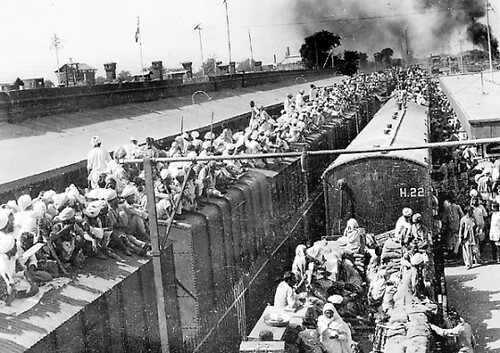In the run-up to Partition, the RSS prepared Hindus and Sikhs of undivided Punjab to face the inevitable that had been imposed on them.
As the country starts celebrations for the 75th year of India’s independence, an integral part of this history is Partition, a momentous tragedy that uprooted millions and resulted in immense bloodshed.
The Rashtriya Swayamsevak Sangh (RSS), a relatively young organisation at the time as it was only set up in 1925, was still at a nascent stage in terms of organisational outreach. It, however, played an important role during the Partition days, which hasn’t been discussed much.
In the run-up to India being divided, the RSS realised the need to prepare Hindus and Sikhs of undivided Punjab to face the inevitable that had been imposed on them.
The second sarsanghchalak (chief) M.S. Golwalkar, also known as Guruji, the first RSS pracharak Babasaheb Apte, and Balasaheb Deoras, who became third sarsanghchalak in 1973, extensively toured the country in the months before Partition.
Hundreds of young men and middle-aged people began joining the Sangh, especially in cities and villages of pre-Partition Punjab, such as Rawalpindi, Lahore, Peshawar, Amritsar, Jalandhar, and Ambala, among others.
The English Tribune wrote (Ref. ‘The Saffron Surge: Untold Story of RSS Leadership, Prabhat Prakashan’), “Punjab is the sword arm of Hindustan and RSS is the sword arm of Punjab.”
The mouthpiece of the Muslim League, Dawn, reacted by writing, “If Congress leadership wishes to receive co-operation from Muslims, then it must ban the Sangh immediately.”
RSS in Punjab
Guruji went to Sialkot and Montgomery after touring Multan in 1946-47. He entered Sindh from Punjab. The province of Sindh had around 80 shakhas at that time. There were 52 pracharaks that included Lal Krishna Advani.
To implement the plan to Partition India, the British government had divided the army and the police on the basis of religion, a few months prior to the final act.
Thus, areas falling under Sindh, West Pakistan, and East Bengal were put under the command of a Muslim-dominated army-police combine. The Hindus in these areas were on tenterhooks. They were sitting on a powder keg with no one to be their saviours.
Guruji took the initiative to reach out to these Hindus and set up the Punjab Relief Committee and the Hindu Sahayata Samiti (Hindu Support Committee). The centre of activity for both of these was initially Lahore. The Punjab state sanghchalak, Raibahadur Badridas, was the chairman and Dr Gokulchand Narang was the treasurer of these committees.
Recalling the role of the RSS’ swayamsevaks during Partition, Professor A.N. Bali, in his book Now It Can Be Told, wrote that the RSS was ever-present in Punjab.
“Who came to the rescue in those difficult times to protect the people, except those young men known as RSS. They arranged for safe passage of women and children in each and every mohalla, in every city of the state,” he wrote.
“They arranged for their food, medical help, and clothing and took care in every possible way. They organised fire-fighting teams in different cities and towns. They arranged for lorries and buses to carry the escaping Hindus and Sikhs and posted defence teams in railway trains.”
Bali wrote that even Congress leaders took the help of the RSS.
“They patrolled relentlessly in different Hindu and Sikh localities. They trained people in self-defence. They were the first ones to reach these terrified people, first to help them and were the last to come to secure places in east Punjab,” he wrote.
“I can recount the names of many well-known Congress leaders in different districts of Punjab who took help from the RSS, for their own security and security of their families. They never ignored any call for help. There were many cases where Sangh volunteers took Muslim women and children from Hindu mohallas to Muslim League refugee camps.”
Bali was an academician in Panjab University and witnessed the carnage in Lahore and surrounding areas himself, after which he penned his book that was published in 1949. It was republished a couple of years ago by Delhi-based Prabhat Prakashan.
“When the entire Punjab was on fire and Congress leaders were sitting helplessly in Delhi, at that time volunteers of RSS saved the people of Punjab with their discipline, and physical strength, risking their own lives,” he wrote.
“Each and every person from amongst the refugees who came from West Pakistan is indebted to the Sangh. When everybody had abandoned them, only the Sangh stood by them.”
How RSS expanded in Punjab
Manik Chandra Vajpayee and Shridhar Paradkar have documented the rapid expansion of the RSS in Punjab in a short period of about a decade.
In an interesting book titled Partition Days — The fiery saga of RSS, published in 2002, they wrote that initially, three RSS pracharaks were sent to Punjab in the mid-1930s, and, within the span of a decade, the RSS had more than 100 pracharaks working in undivided Punjab, with 58 of them coming from Lahore itself.
There were more than 1,500 RSS daily shakhas with a daily attendance of more than one lakh swayamsevaks in undivided Punjab. The three pracharaks who were sent initially from Nagpur to Punjab were K.D. Joshi, Digambar Paturkar and Moreshwar Moonje.
The RSS activities got a big fillip when Madhav Rao Muley was appointed as the prant pracharak in Punjab around 1940.
It was due to its strong organisational strength in Punjab that RSS was able to save Hindus and Sikhs from communal violence and bring them safely to India.
This also busts the myth that the RSS was an organisation that was mainly supported by Chitpavan Brahmins in Maharashtra as, by 1947, it had reached almost every district from Delhi to Peshawar.
(The Article was first published in The Print on 5 September, 2021 – https://theprint.in/india/only-sangh-stood-by-them-how-rss-helped-sikhs-and-hindus-of-punjab-during-partition/714850/ )
